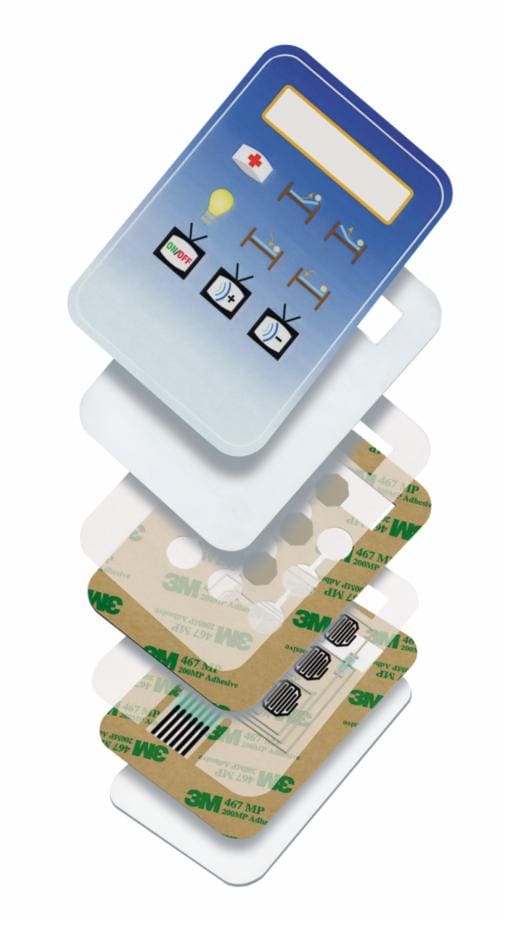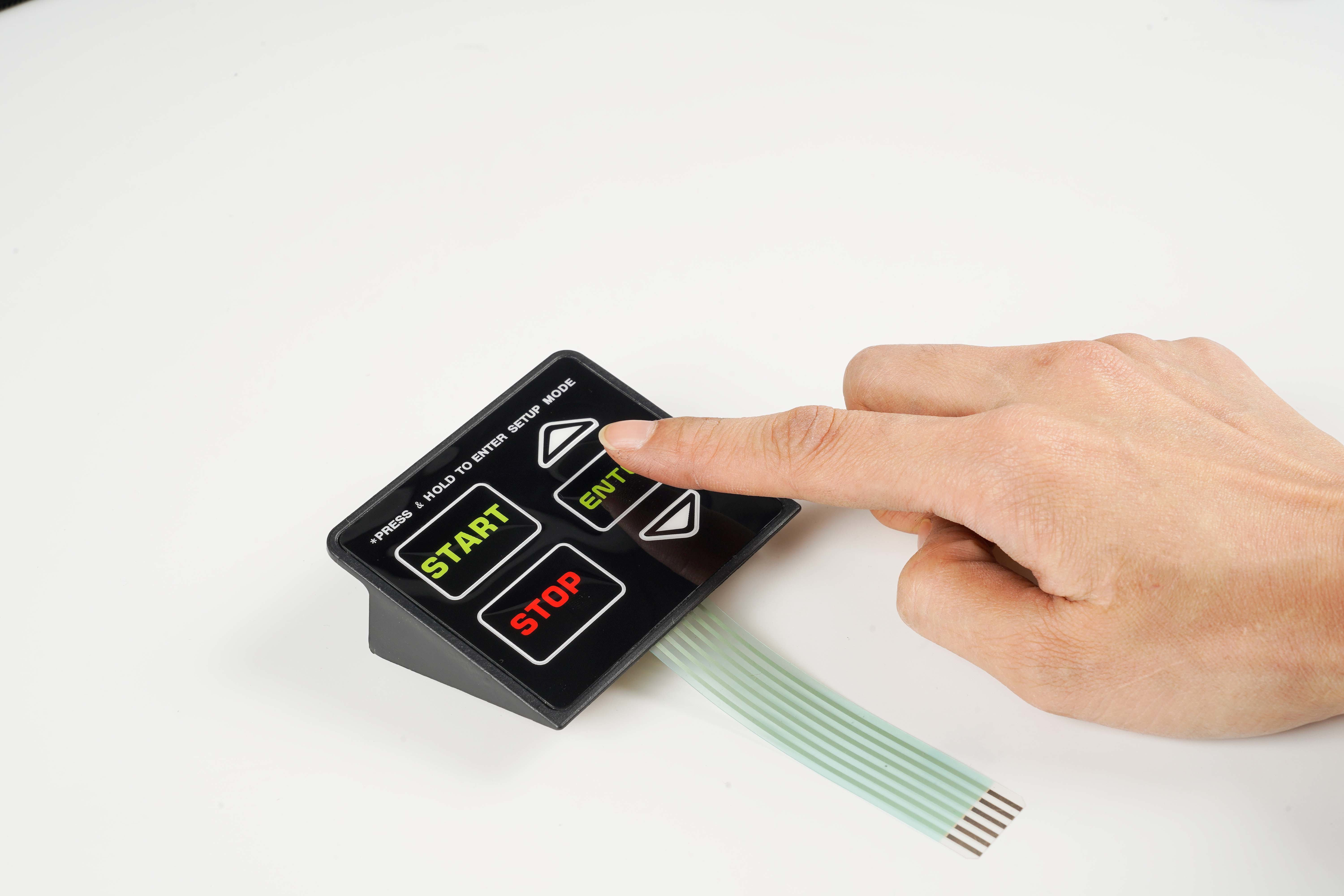Everything About Membrane Switch Over: A Comprehensive Overview for Beginners
Membrane buttons are important elements in contemporary electronics, offering a distinct interface for individual interaction - membrane switch. Their split building, consisting of overlays and conductive traces, provides performance and longevity. Unlike traditional mechanical switches, membrane layer buttons provide a smooth style and adjustable alternatives. Comprehending their key functions and benefits can transform product layout. Nevertheless, the ins and outs of their application and layout considerations necessitate more expedition
What Is a Membrane layer Switch?
A membrane layer button is a kind of electrical button that contains an adaptable membrane layer layered over a printed circuit card. This layout enables a portable and smooth interface, typically made use of in different electronic tools. Membrane layer switches are frequently discovered in customer devices, clinical equipment, and commercial machinery because of their durability and resistance to ecological factors.The building typically includes several layers, such as visuals overlays and glue backing, which supply responsive comments and secure the wiring beneath. The operation of a membrane switch is started when pressure is related to the surface, finishing an electric circuit.These switches are valued for their convenience, allowing custom-made layouts and published graphics that deal with particular user interfaces. Their low-profile nature decreases space demands, making them ideal for applications where standard buttons might not fit. Overall, membrane buttons provide a practical and aesthetic solution for modern digital tools.
Trick Components of Membrane Layer Switches Over
Membrane layer switches consist of numerous vital parts that contribute to their functionality and efficiency. The leading layer, called the overlay, offers the customer interface and is usually printed with graphics or icons. Underneath the overlay lies a spacer layer, which separates the conductive components and avoids unintended activation. The next vital part is the visuals layer, which boosts aesthetics and ensures the resilience of the design.Conductive traces, normally made from materials like silver or carbon, are printed on the circuit layer. When stress is put on the overlay, these traces enter into get in touch with, completing the circuit. Additionally, a backing layer offers architectural support and can be made from products such as polyester or polycarbonate. With each other, these components produce a trusted, user-friendly user interface ideal for various applications, from house devices to industrial tools. Comprehending these elements is important for any person curious about membrane switch modern technology.
Exactly How Membrane Changes Work
Understanding exactly how membrane layer switches over feature is essential for appreciating their extensive usage in various gadgets. A membrane switch operates with a series of layers, including a visuals overlay, spacer, and a circuit layer. When pressure is applied to the overlay, it presses the spacer layer, permitting the circuit layer to make contact and finish an electric circuit. This activity sends out a signal to the gadget, triggering a reaction, such as transforming on a light or activating a function.Membrane switches over can be created with numerous functions, including tactile responses, backlighting, and personalized graphics, enhancing individual interaction. Their building allows for a closed layout, shielding the inner elements from dirt, wetness, and impurities. This durability makes them ideal for varied applications, from customer electronics to commercial tools. In general, the simpleness and effectiveness of membrane layer switches contribute to their appeal in modern technology.
Advantages of Membrane Layer Switches Mechanical Buttons
While mechanical switches have long been a staple in lots of tools, membrane layer switches offer unique benefits that make them significantly appealing. One significant benefit is their slim account, permitting for more small styles and better versatility in item growth. In addition, membrane layer switches feature an uniform surface, which improves aesthetic charm and streamlines cleaning, making them appropriate for settings where health is critical.Another advantage is their resistance to dirt and moisture. Unlike mechanical switches, which can be compromised by ecological aspects, membrane buttons supply a closed interface that protects against pollutants - membrane switch. Membrane layer switches usually have a longer life-span due to less moving components, resulting in improved longevity and reliability.Cost-effectiveness is likewise a significant advantage, as membrane layer switches can be generated in bulk with reduced manufacturing expenses. These variables integrate to place membrane buttons as a useful choice to typical mechanical alternatives in different applications
Typical Applications of Membrane Layer Changes
Membrane layer buttons are widely used in numerous industries, specifically in customer electronic devices and commercial control board. In consumer tools, they give a streamlined, straightforward interface, while in commercial settings, they enhance resilience and functionality. Comprehending these applications highlights the flexibility and functionality of membrane layer buttons in modern-day technology.
Customer Electronics Tools
As customer electronics proceed to advance, membrane layer buttons have actually come to be a popular option for a range of devices due to their convenience and smooth design. These switches are generally discovered in smartphones, tablets, and push-button controls, where space is restricted and visual appeals issue. Their low account and customizable layouts allow manufacturers to create user-friendly user interfaces that boost the overall customer experience. In addition, membrane layer buttons are typically used in home appliances such as microwaves and coffee makers, providing user-friendly control alternatives while standing up to wetness and dust. The toughness and reliability of membrane layer changes make them suitable for everyday customer items, making certain long life and consistent performance. In general, their assimilation additional reading in consumer electronic devices reflects a blend of capability and modern-day layout.
Industrial Control Panels
The applications of membrane switches expand past consumer electronic devices, finding significant usage in commercial control board. These switches are preferred for their toughness and resistance to harsh settings, making them perfect for making and procedure control setups. They give a trusted user interface for operators to control machinery, display processes, and change settings. Membrane layer buttons can be personalized to suit details functional needs, integrating attributes like backlighting and tactile responses, enhancing user experience. Their inconspicuous design permits integration into different devices, while their capability to stand up to spills, dust, and severe temperatures guarantees long life. Overall, membrane layer switches add to reliable and risk-free operation in commercial applications, demonstrating their adaptability and performance in demanding atmospheres.
Considerations for Creating Membrane Layer Switches Over
When developing membrane layer switches, picking the appropriate products is essential to assure durability and performance. Additionally, understanding layer configuration methods can significantly affect the switch's performance and customer experience. These considerations play an essential function in producing reliable and reputable membrane layer button designs.
Material Choice Significance
Product choice plays a vital function in the style and functionality of membrane buttons. The picked products straight influence the switch's toughness, responsive action, and overall visual. Secret considerations include the substrate, which must supply architectural integrity while permitting versatility, and the graphic overlay, which needs to be immune to wear and ecological factors. Conductive materials need to assure trusted electric efficiency, while adhesives should supply solid bonding without jeopardizing the button's operation. Additionally, compatibility with producing processes and end-user environments is important; products have to withstand varying temperature levels, moisture degrees, and chemical exposure. Ultimately, ideal product choice not only enhances the membrane switch's efficiency but likewise adds to its durability and customer contentment, making it an essential aspect of the design process.

Layer Arrangement Techniques

Frequently Asked Inquiries
The Length Of Time Do Membrane Layer Switches Over Commonly Last?
Membrane buttons generally have a life expectancy of 1 to 5 million cycles, relying on use and environmental problems. Factors such as design top quality and operating frequency considerably affect their resilience and overall performance long life.

Can Membrane Layer Switches Over Be Custom-made for Particular Designs?
Membrane layer switches can without a doubt be customized to suit details designs, permitting diverse shapes, shades, and performances. This flexibility makes it possible for producers to tailor these switches to meet unique aesthetic and operational demands successfully.
What Materials Are Used in Membrane Switch Construction?
Membrane layer switches are normally constructed using materials such as polyester, polycarbonate, and sticky layers. These materials offer resilience, flexibility, and resistance to environmental aspects, making certain the buttons function successfully in different applications and conditions.
Are Membrane Layer Switches Over Immune or waterproof to Moisture?
Membrane buttons can be developed to be moisture-resistant, making use of specialized products and layers. Nonetheless, their waterproof capacities rely on building and construction quality and particular applications, making it necessary to evaluate needs for suitable efficiency in various environments.
Just How Are Membrane Layer Changes Repaired if Damaged?
Fixing damaged membrane layer switches usually involves replacing the influenced layer or circuit. Service technicians may additionally use conductive adhesive or make use of specialized repair work packages, making certain performance is restored without full replacement of the whole button setting up. Unlike conventional mechanical switches, membrane layer switches provide a streamlined style and adjustable options. A membrane switch is a type of electrical button that is composed of an adaptable membrane layered over a published circuit board. The procedure of a membrane switch is launched when stress is used to the surface, completing an electric circuit.These buttons are valued for their adaptability, making it possible for custom styles and printed graphics that cater to details customer interfaces. While mechanical buttons have long been a staple in numerous tools, membrane layer switches offer distinctive advantages that make them progressively appealing. Membrane layer buttons usually have a longer life-span due to less relocating components, resulting in boosted sturdiness and reliability.Cost-effectiveness is additionally a remarkable benefit, as membrane switches can be generated in mass with reduced manufacturing prices.